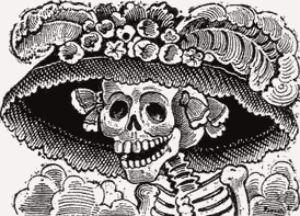|
|
José Guadalupe Posada (2 February 1854 – 20 January 1913) was a Mexican engraver and illustrator.
He was born in Aguascalientes, Aguascalientes. He learned the art of lithography, and by 1871 he was working for a local newspaper called El Jicote (The Hornet). After a few year, he eventually joined the staff of the Mexico City publishing firm of Antonio Vanegas Arroyo.
Posada's best known works are his calaveras, or skeletons, which often assume various costumes, such as the Calavera de la Catrina, the "Skeleton of the Female Dandy", which was meant to satirize the life of the upper classes during the reign of Porfirio Díaz. Most of his imagery was meant to make a religious or satirical point; since his death, however, his images have become associated with the Mexican holiday Día de los Muertos, the "Day of the Dead". They draw on medieval art traditions of the danse macabre and Native American motifs.
Largely forgotten by the end of his life, Posada's engravings were brought to a wider audience in the 1920s by the French artist Jean Charlot, who encountered them while visiting Diego Rivera. While Posada died in poverty, his images are well known today as examples of folk art. The muralist José Clemente Orozco knew Posada when he was young, and credited Posada's work as an influence on his own.
External link
- José Guadalupe Posada, Printmaker (http://muertos.palomar.edu/posdad.htm)
- José Guadalupe Posada and Corridos of the Mexican Revolution (http://www.art.unt.edu/artbase/art_history/mock/) by Melody Mock
- José Guadalupe Posada (http://elibrary.unm.edu/posada/) at the University of New Mexico
- Mexico's Daumier: José Guadalupe Posada (http://www.mexconnect.com/mex_/history/jtuck/jtjgposada.html)

